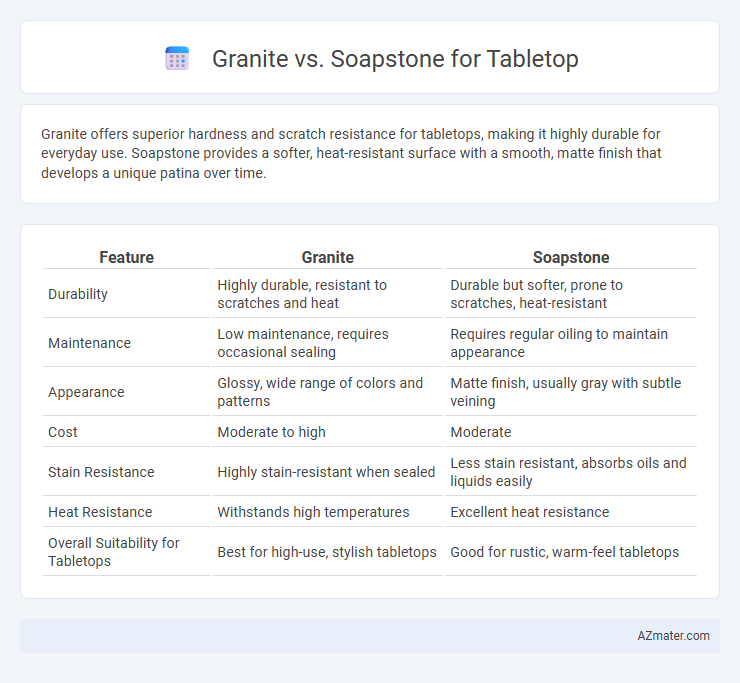Granite offers superior hardness and scratch resistance for tabletops, making it highly durable for everyday use. Soapstone provides a softer, heat-resistant surface with a smooth, matte finish that develops a unique patina over time.
Table of Comparison
| Feature | Granite | Soapstone |
|---|---|---|
| Durability | Highly durable, resistant to scratches and heat | Durable but softer, prone to scratches, heat-resistant |
| Maintenance | Low maintenance, requires occasional sealing | Requires regular oiling to maintain appearance |
| Appearance | Glossy, wide range of colors and patterns | Matte finish, usually gray with subtle veining |
| Cost | Moderate to high | Moderate |
| Stain Resistance | Highly stain-resistant when sealed | Less stain resistant, absorbs oils and liquids easily |
| Heat Resistance | Withstands high temperatures | Excellent heat resistance |
| Overall Suitability for Tabletops | Best for high-use, stylish tabletops | Good for rustic, warm-feel tabletops |
Introduction: Choosing the Right Material for Your Tabletop
Granite and soapstone are popular materials for tabletops, each offering distinct benefits that cater to different needs and aesthetics. Granite is known for its durability, heat resistance, and a wide variety of color options, making it ideal for high-traffic areas and modern designs. Soapstone, with its silky texture and natural resistance to stains and heat, provides a softer, rustic appeal that darkens and gains character over time.
Granite vs Soapstone: Overview and Key Differences
Granite and soapstone are popular choices for tabletops, with granite offering superior hardness and resistance to scratches due to its high quartz and feldspar content, making it ideal for heavy-use surfaces. Soapstone, composed mainly of talc, is softer yet highly heat-resistant and non-porous, providing excellent stain resistance and ease of maintenance. Key differences include granite's polished, glossy finish and wider color variations versus soapstone's matte appearance and natural ability to darken over time with use.
Durability and Strength Comparison
Granite tabletops offer superior hardness and scratch resistance due to their high quartz content, making them highly durable for daily use. Soapstone, while softer and more prone to scratches, exhibits excellent heat resistance and can withstand thermal shock better than granite. Both materials provide long-lasting strength, but granite is preferred for heavy-duty durability, whereas soapstone's slightly softer nature allows for easier repair and maintenance.
Aesthetic Appeal: Colors, Patterns, and Texture
Granite tabletops exhibit a vibrant range of colors and intricate patterns, featuring speckled and veined textures that add dynamic visual interest. Soapstone offers a softer, more uniform appearance with smooth, matte finishes and subtle veining, often in muted gray or green tones. The choice between granite and soapstone hinges on whether a bold, polished look or a sleek, natural aesthetic better complements the design environment.
Maintenance Requirements: Cleaning and Care
Granite tabletops require sealing every 1-2 years to maintain stain resistance, with daily cleaning using mild soap and water to avoid etching. Soapstone tabletops are naturally non-porous, eliminating the need for sealing, and care involves routine wiping with a damp cloth and occasional application of mineral oil to enhance its rich patina. Both materials resist heat well, but granite demands more vigilant maintenance to prevent damage from acidic spills, whereas soapstone's surface tends to mellow gracefully over time.
Stain and Scratch Resistance
Granite offers superior stain resistance due to its dense, non-porous surface, making it highly durable against spills and everyday wear. Soapstone, while softer and more prone to scratches, develops a unique patina over time that can be sanded out to restore its smooth finish. For tabletop use, granite is ideal for environments demanding high scratch and stain resistance, whereas soapstone suits users who appreciate its natural aging and easy maintenance.
Heat and Chemical Tolerance
Granite tabletops exhibit exceptional heat resistance, tolerating temperatures of up to 480degF without damage, making them ideal for placing hot pots or pans directly on the surface. In contrast, soapstone has slightly lower heat tolerance, around 200-300degF, but its dense, non-porous structure resists chemical stains and acids much better than granite, preventing etching or discoloration from common household chemicals. Both materials offer durable surfaces, but soapstone's superior chemical resistance makes it preferable in kitchens prone to acidic spills, while granite excels in environments requiring high heat endurance.
Cost Analysis: Price Comparison
Granite tabletops typically range from $40 to $100 per square foot, making them a durable yet moderately priced option for kitchen and dining surfaces. Soapstone, generally costing between $70 and $120 per square foot, is often priced higher due to its unique softness and heat resistance. When considering installation and maintenance, granite tends to offer a lower long-term cost compared to soapstone, which may require more frequent sealing and care.
Eco-Friendliness and Sustainability
Granite and soapstone both offer durable options for tabletops, with soapstone being more eco-friendly due to its natural, non-toxic properties and lower environmental impact during quarrying. Soapstone's high magnesium content and resistance to chemicals reduce the need for sealants and harsh cleaners, enhancing sustainability. Granite's extraction process typically involves more energy and waste, though it remains a long-lasting choice that can reduce replacement frequency.
Conclusion: Which is Better for Your Tabletop?
Granite offers unmatched durability and scratch resistance, making it ideal for high-traffic tabletops that endure heavy use. Soapstone provides a softer, heat-resistant surface with a unique, smooth patina that improves over time but requires more maintenance to prevent scratches. Choose granite for longevity and toughness, while soapstone suits those seeking natural warmth and a more tactile, evolving aesthetic.

Infographic: Granite vs Soapstone for Tabletop
 azmater.com
azmater.com